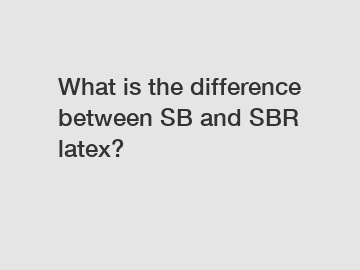Dec. 29, 2023
Chemicals
Latex is a versatile material widely used in various industries, including automotive, construction, healthcare, and textiles. A confusion that often arises is the difference between SB (Styrene Butadiene) latex and SBR (Styrene Butadiene Rubber) latex. In this article, we will explore these two types of latex, highlighting their dissimilarities and addressing the misconceptions around them.
What is Latex?
Before delving into SB and SBR latex, let's understand the basics. Latex is a stable dispersion of polymer microparticles in an aqueous medium. It is derived from natural sources, such as rubber tree sap (natural latex), or synthesized chemically to achieve specific properties (synthetic latex). SB and SBR latex fall under the category of synthetic latex.

SB Latex:
SB latex, also known as Styrene Butadiene Copolymer, consists of two main monomers: styrene and butadiene. The styrene component imparts hardness and rigidity, while butadiene contributes to flexibility and resilience. SB latex is widely used due to its excellent mechanical properties, such as good tensile strength, abrasion resistance, and low-temperature flexibility.
With its inherent strength, SB latex finds applications in the carpet industry, where it enhances the durability and longevity of carpets. It is also frequently used in paper coatings, adhesives, and construction products like sealants and binders. SB latex is preferred for these applications due to its exceptional water resistance and adhesive properties.
SBR Latex:
On the other hand, SBR latex, or Styrene Butadiene Rubber, is a type of latex derived from the copolymerization of styrene and butadiene with emulsion polymerization techniques. This synthesis imparts rubber-like qualities to the latex, making it widely used in the production of various consumer goods. SBR latex possesses excellent abrasion resistance, good elastic properties, and an impressive ability to withstand extreme temperatures.
Due to its enhanced elasticity and elongation properties, SBR latex is commonly used in the manufacturing of foam rubber products, including mattress cushions, pillows, and automotive seating. Additionally, SBR latex also finds its application in the construction industry, specifically for manufacturing waterproofing membranes, roofing materials, and transportation belts.
Differences Between SB and SBR Latex:
While SB and SBR latex share similar chemical components, their performance characteristics differ significantly. The primary contrast lies in their hardness and flexibility. SB latex is generally harder and more rigid, whereas SBR latex exhibits greater flexibility and resilience. Consequently, the applications of these two types of latex vary accordingly.
Another difference is in their water resistance capabilities. SB latex, being less flexible, offers superior water resistance compared to SBR latex. SB latex is an excellent choice for applications where exposure to moisture is common or where water resistance is a crucial requirement. SBR latex, while offering good water resistance, may not be as effective in extremely wet conditions.
Application Considerations:
Though SB and SBR latex have their unique applications, occasional overlap can occur. For instance, both types find use in the textile industry for coating fabrics. However, SB latex is more favored for high-performance applications where water resistance and durability are key, while SBR latex is suitable for less demanding situations.
It is important to note that the selection of the appropriate latex type relies on extensive research, considering the specific requirements of each application. Consulting with industry experts and manufacturers is crucial to make informed decisions, ensuring optimal performance and cost-effectiveness.
Conclusion:
Understanding the distinction between SB and SBR latex is essential for various industries that rely on latex for their products. While SB latex provides hardness, rigidity, and exceptional water resistance, SBR latex offers flexibility, resilience, and good elastic properties. By considering their individual characteristics, manufacturers can make informed decisions about which type of latex to choose for their intended applications.
Remember, collaboration with industry experts, certification bodies, and reputable manufacturers allows you to tap into their deep expertise, ensuring you benefit from the latest advancements in latex technology. Ultimately, selecting the right latex type will provide improved product performance, durability, and customer satisfaction.
Want more information on sbr latex emulsion, phosphate modified polyacrylate emulsion, Styrene Butadiene Latex for Bitumen? Feel free to contact us.
If you are interested in sending in a Guest Blogger Submission,welcome to write for us!
All Comments ( 0 )